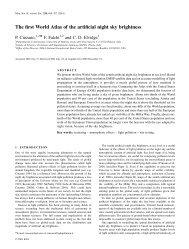slides
slides
slides
You also want an ePaper? Increase the reach of your titles
YUMPU automatically turns print PDFs into web optimized ePapers that Google loves.
Recent methods to map artificial night sky brightness and stellar<br />
visibility across large territories or their distribution over the entire sky at<br />
any site, are based on the computation of the propagation of light<br />
pollution with Garstang models, a simplified solution of the radiative<br />
transfer problem in atmosphere which allows a fast computation by<br />
reducing it to a ray-tracing approach. They are accurate with clear<br />
atmosphere, when a two-scattering approximation is acceptable, which<br />
is the most common situation.<br />
I present here up-to-date Extended Garstang Models (EGM) which<br />
provides a more general numerical solution for the radiative transfer<br />
problem applied to the propagation of light pollution in atmosphere.<br />
(Cinzano, in prep.)<br />
I also present the LPTRAN software package, an application of EGM<br />
to DMSP-OLS radiance measurements and to GTOPO30 digital<br />
elevation data, which provides an up-to-date method to predict the<br />
artificial brightness distribution of the night sky at any site in the World<br />
at any visible wavelength for a broad range of atmospheric situations<br />
and the artificial radiation density in atmosphere across the territory.



